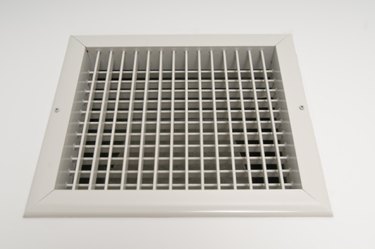
Ventilation is the process of moving air. Air vents were plentiful in older homes before more complex heating systems and central air-conditioning were developed. These air ducts, located in the floor and in the walls, helped regulate environmental factors, keep the houses operational and keep the people in them healthy.
Heating
Video of the Day
Before standardized building codes using mechanical heating were enacted, older homes utilized the main stairway as a heat exhaust vent system that led to upper rooms. These homes also utilized non-mechanical static vents or floor grates that covered a hole in the ceiling or cut into a wall. This allowed rising heat to pass from a basement, fireplace or room heating source to other rooms. These systems included steam- or forced hot-water-based radiators that carried steam to radiators regulated by steam vents. The vent allowed air to escape as the steam from the boiler filled the radiator. After the radiator filled with steam, a piston inside the air vent expanded to close the valve. Often, air vents in older homes can get corroded or clogged so the vent won't open. If it does not open, no steam fills the radiator and the house will not heat. A solution is to unclog the vent or install a new vent.
Video of the Day
Cooling
Excessive heat buildup can kill humans and cause house fires. Non-mechanical cooling vents, called "static vents," allow cool air to enter an old house. It might enter the basement through "foundation vents." Vents can also be installed in walls of an older home. Ridge vents are utilized on the exterior of an attic, combined with intake vents. Some houses utilize a huge "whole house fan" in the attic to suck hot interior air through sheet metal ducts, then blow it out through static vents.
Moisture Control
Construction materials used in older homes can be damaged from too much moisture. Static vents, positioned throughout older homes, controlled moisture. In some older homes, wall air vents helped remove moisture build-up between exterior and interior walls. This prevented mold from growing prior to the invention of sealants. Removing excessive interior moisture mechanically though metal ducts and static vents required taking the moist air and circulating it through a dehumidifying system.
Toxic Gas Removal
Plumbing air vent stacks are the structures that allow your toilet to flush and prevent sewer gas from coming in. These stacks allow effective exchange between air and water throughout the plumbing system. This vent also helps expel sewer gas into the air, protecting people from disease and other airborne bacteria. In older homes, these vents were made of heavy cast iron. Prior to modern indoor plumbing and ventilation, homeowners used an outdoor toilet, known as the outhouse.
- Whole Building Design Guide; Natural Ventilation; Andy Walker; June 15, 2010
- Air Vent Inc: Types of Ventilation
- Old House Mechanic: Repairing Steam Air Vents
- Your Houston Home Inspector: Improving Your Return Air Ducts in Older Homes
- DIY Plumbing and Drain: Plumbing
- This Old House; Improving Attic Ventilation; Merle Henkenius
- Dehumidifier Experts: The Dangers of High Humidity in Your Home
- American Society of Heating, Refrigerating and Air-Conditioning Engineers
- The Plumber.com: History of Plumbing in America
- Environmental Protection Agency: Should You Have the Air Ducts in Your Home Cleaned?
- Bob Vila: New Air-Conditioning for Old House
- Old House Web; No Air Ducts?; How to Add Air Conditioning to Your Old House; Scott Gibson